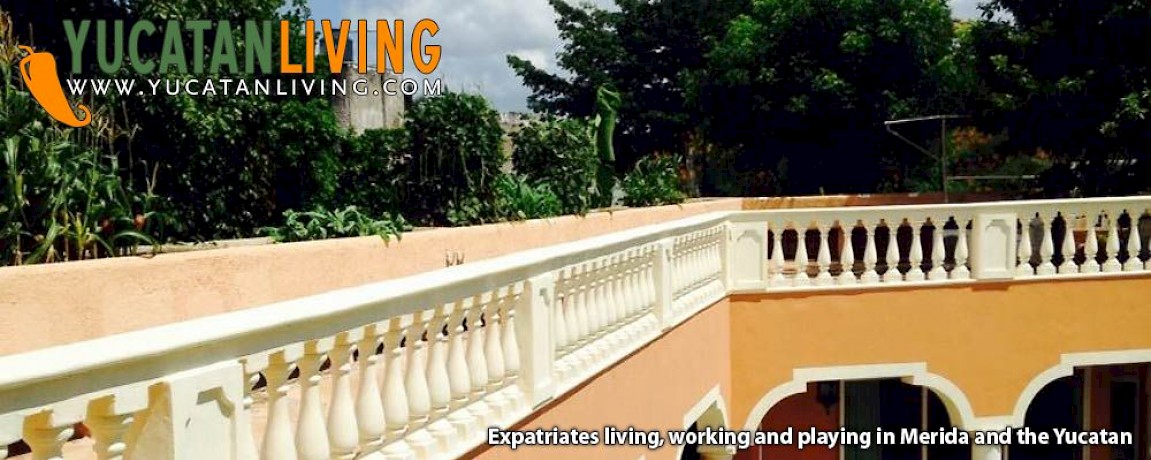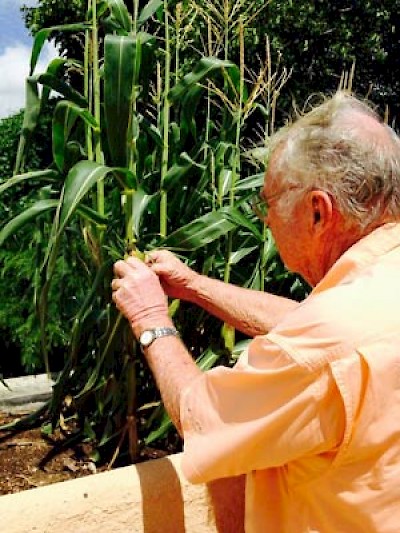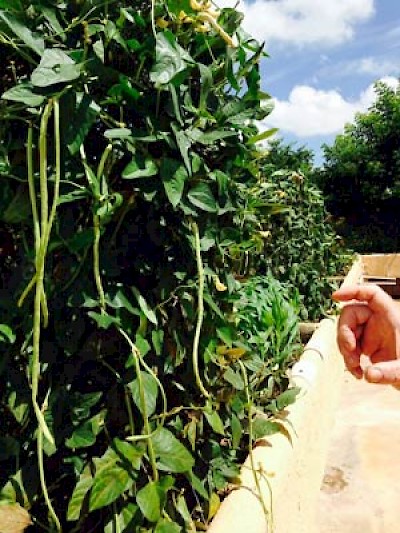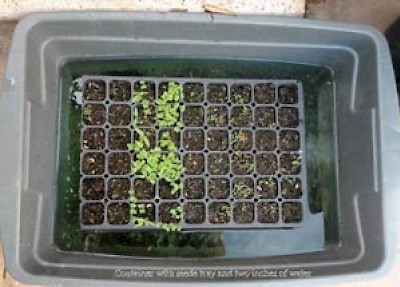Gardening in Yucatan: Planning & Planting
Planning your garden is always a good idea, but it is especially important especially in the Yucatan. In areas where there is ample space for a garden, just turning over the soil and digging a row, throwing in some seeds and fertilizer is a common way of gardening. But with all the knowledge and resources now available, garden can involve a lot more and but also can produce a lot more.
Poor Soil? You Are Not Alone
In the Yucatan, it helps to know that most of the area around Merida and much of the rest of the Yucatan has about four inches of poor soil. Beneath that is limestone... not an idea environment for growing vegetables. In fact, there are not many food plants that grow well under these conditions, so building a raised garden is almost a must in this environment.
The garden containers should be raised, and then filled with a mixture of compost, manure and vermiculite. You could also mix in some good soil which comes in plastic bags from Vigero or from one of the other name-brand soil producers. NEVER buy soil from the guys with the burros selling dirt from their carts door to door. It has almost no nutrients and is usually contaminated. If you are going to spend your time and money creating and nurturing a garden, you might as well start with a good growing medium. Building your growing medium can be costly, and it takes time too... but it pays off with more abundant harvests.
Up On The Roof
Since we did not have space in our yard, we put our garden on the roof. Rooftop gardening has the advantage of using previously-unused space, while helping to insulate your roof and has become very popular all over the world. Container gardening is a good choice in general, as you only have to spend money for the growing medium in the place where you are going to plant. If you raise your container to the height of a table, you eliminate the bending and squatting normally associated with planting, tending and harvesting your garden. Another important advantage of raised containers is that you get the plants up and away from many of the insects that prefer to hide in the damp and shady areas of your garden. Container gardening also conserves water, which may not be an issue in the Yucatan, but should always be considered. In containers, you are only using water where the plants are and not in walkways and other unplanted areas. Well water is preferred over city water in Merida, by the way. City water has many chemicals added to it to make it drinkable, but these are not always ideal for your plants.
Location Is Key
Select your garden location so your plants will get a minimum of six hours of sun per day, keeping in mind that the attitude of the sun changes over time. (The unobstructed exposure to sunshine is one of the advantages of planting on the rooftop). The same area for sun in the summer may not be the same in the winter. A location that is easily accessible makes the garden more enjoyable for you, the gardener. If you are located near the ocean, it is best to select a spot that is shielded by a building or other object that keeps the winds from bringing the salt mist ashore and damaging your plants. We do not know of any salt tolerant vegetable plants, so this is really an important consideration. And most plants do not like constant wind of any kind, so be sure to plant somewhere on the roof that does not encounter constant wind.
What To Plant?
When planning your garden we suggest that you make a list of the vegetables you would most like to eat and grow. Review this list and select the ones that grow best in a tropical climate. If you are planting for the summer, you will want things like melons, beans, okra, corn, eggplant, cucumbers, lettuce, kale, Swiss chard, peppers and tomatoes. For the fall and winter you can add squash, broccoli and about any other vegetable you want. Most of the oriental vegetables, like bok choy, do very well in the tropical summers. Also, keep in mind that it is never a good idea to plant the same plant in the same space year after year. If you planted tomatoes in this container or space last year, this year you should plant corn or peppers in that same space. You may also want to consider whether a crop grows vertically or along the ground. Melons grow along the ground and are perfect to plant next to corn, which grows straight up. And also, consider when plants are harvested. If plants are harvested at two different times of the year, perhaps they can be grown in the same space.
It All Begins With A Seed
I like to study the seed catalogs. The selections are good and the descriptions tell you information on so much, including how long from planting to harvest, the height and size of the plants, the flavor of the fruit or vegetable, etc. In our experience, we get a better selection of heat-tolerant plants from seed companies in the South of the United States, where they have similar weather in the summer. Pictured to the right are Chinese long beans which taste delicious and tender, and grow very well in the hot tropical climate of Yucatan. We use mostly the catalog from The Otis Twilley Seed Company in South Carolina and Tomato Growers in Fort Myers, Florida. There are many good, informative seed catalogs; these are just two with whom we have had success. And our experience also shows that time spent selecting seeds is well spent. People are breeding seeds that produce heat-tolerant characteristics, various wilt, mold, and virus resistances and even resistant to nematodes (and yes, we do have nematodes here in the Yucatan). In this climate, we need all the help we can get to resist so many things that want to attack our plants and reduce our yields.
We suggest that you plant your seeds in sterilized soil expressly made for seedlings, and use one of the types of planters pictured here. Each section gets one to two seeds, and the seedlings therefore grow up separately. To water just set your seed flat into a container with 2” of water large enough for the seed flat to sit in. The flats are pictured here and purchased from Jesus Angulo Aldana at Agrocampo, Calle 54- A #501 - J por 65 y 67 in Merida centro (tel 999 923 3333 ext 105.) Water by seating the seed tray in the water bath for a couple of minutes, then removing it and setting it aside in the shade or filtered sun. This will moisten the soil but not damage the tender seedlings as they come up. Watering from the top often disturbs tiny plants and seeds, but this avoids that problem.
Once your seedlings are about 3” or more tall, you can put just where you want them in your garden. This makes for nice even rows with no skips. When possible, transplant the seedlings to their garden spot just before a rain and or after the sun has set. Shade them and keep them well watered for a couple of days to give them their best chance to survive. We find that many vegetables such as tomatoes, melons, peppers, broccoli, and cucumbers do better planted in seed flats and then transplanted carefully to just exactly where we want them.
Words of Caution
Sometimes, you can find starter plants for sale. These can be great, as they get you started in a fast and easy way. There again, care should be taken to know what you are buying and how and where it was grown. Many of the flower seedlings in Mexico are grown in the Cuernavaca area and when they get to the Yucatan they can only stand a few days of the heat before they just wither up and die. Always make sure the plants you are buying were grown in a similar climate area so they do not go into shock. Also, it helps if they were produced in sterilized soil or you may get plants that contaminate your garden.
Especially for container and raised container gardening, pay attention to size and height of plants when you are choosing seeds. Determinate tomatoes for example grow to only four feet tall, but indeterminate tomatoes just keep growing...well, indeterminately. The space plants take is important, especially when space is limited. The book “Square Foot Gardening” by Mel Bartholomew is an excellent reference book as is ”Minifarming” by Markham. We think that the Merida English Library may have both these books, but certainly they are available through Amazon. Google has an enormous amount of information on all aspects of gardening and it is so easy! We have not had a single question that Google did not have the answer to.
Gardens Help Build a Community
When buying seeds keep in mind your planting plan and how many seeds you will need. For example there may be 25 seeds in an eggplant packet but you may want to plant only four. Buy small packets because seeds lose their ability to germinate over time, and are difficult to keep. Here in the Yucatan it is necessary to store seeds in an air tight container in the refrigerator if you want them to remain viable.
If you end up with more seeds than you need, share or exchange seeds with a fellow gardener! Get to know others who are gardening here in Merida and the Yucatan and exchange information and ideas. And when harvest comes, exchange fruit and vegetables too! Exchanging seeds, harvests and ideas with other gardeners is one of the joys and rewards of gardening.
If you have any gardening questions, please use the comment section below to send them and we will answer them here or in our next articles.











Comments
Sarah Chesnutt 6 years ago
Hello, do you know of an ornamental or ground cover plant that would do ok where water drains and the soil has a lot of crushed limestone? I can amend the soil to be less alkaline but what would be most tolerant? Thanks!
Reply
jan simpson 8 years ago
I will be moving to Chelem this summer and will be setting up my home garden to provide my fresh vegetables and flowers
I will look forward to your periodic new letters and information sharing. thanks you
Reply
Victor Arzate 11 years ago
Dearest Mary,
Can you please let me know if "Aqua de Tehuacan" is still on the market in Mexico? In my estimation it is as good as Perrier or Evian and a natural source in Mexico for centuries. Thanks, Victor
Reply
Working Gringos 11 years ago
Thank you, Mary!
Reply
Mary Maas 11 years ago
The city water in Mérida is potable (drinkable) when it leaves the water processing plant -- but there is always a chance of contamination from old pipes (before the water reaches your house), or even from storage in a poorly maintained tinaco. For those reasons, most folks use bottled water (agua purificada) for drinking. In some smaller municipios, there have been questions/issues about how well the water plants are maintained, and whether the clorination is done properly, so outside of Mérida, I would be even more cautious about drinking tap water.
Reply
Roberto 11 years ago
We have been rooftop gardening here in Merida for five years and find it very rewarding. If there are any questions or if we can help you or if you would like to drop by and see what we are doing, just let us know. If there is interest after everyone returns we will be glad to have an "open garden" and question and answer session one afternoon. There are quite a few experienced gardeners here that are always willing to share.
All the best,
Roberto
Reply
Roberto 11 years ago
We do not know anyone who drinks the Merida water, native Meridians or ex pats. All the guys on our construction crew drink only bottled water. Who would ever have thought bottled water would become such a large business?
Reply
Mary Maas 11 years ago
What a very thoughtful article! I appreciate the reminders to new gardeners to look for plants adapted to the local environment, and to focus on information for tropical gardening, rather than becoming frustrated by trying to import temperate-climate planting practices. To respond to Dave Brody's question above, check out Yucatan
Association of Gardeners -- https://www.facebook.com/groups/YAGarden/ -- it's an English-language group of gardeners, started on Facebook, but meets monthly in centro Merida. For Spanish-speakers, Sociedad de Plantas Nativas de Yucatan, also via Facebook https://www.facebook.com/groups/plany/ focuses on (obviously) native plants. Many members are English speaking, and the talks are very informative.
Reply
TJ 11 years ago
Does this mean that the city water in Merida is drinkable?
Reply
David Brody 11 years ago
Thanks for a very informative article. When we live in Merida full-time we will certainly make use of the information. Currently, we are still in the U.S (N.J.) and we grow vegetables, berries, and herbs. I would hate to give up a favorite hobby, not to mention the fact that our children would never forgive us if we could not supply them with jam and jelly. Do you know if berries do well in Merida? We would also be interested in finding out if any gardening clubs exist in the area.
Keep up the good work,
Dave Brody & Joanne Liegner
Reply
(0 to 10 comments)